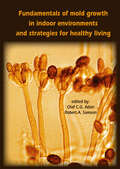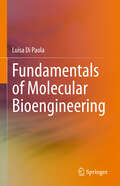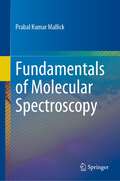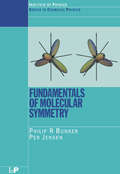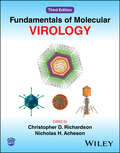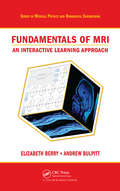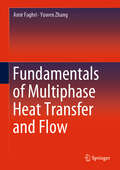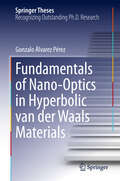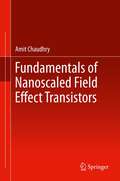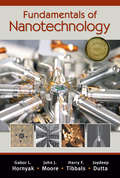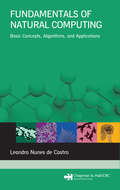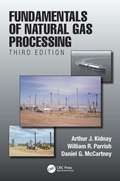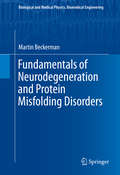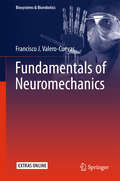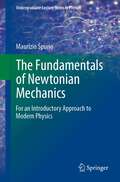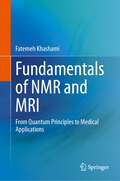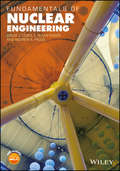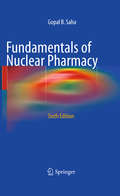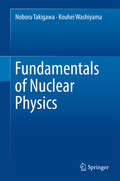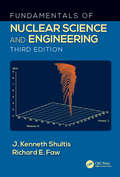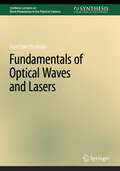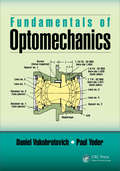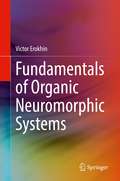- Table View
- List View
Fundamentals of mold growth in indoor environments and strategies for healthy living
by Olaf C.G. Adan Robert A. SamsonToday, indoor mold and moisture, and their associated health effects, are a society-wide problem. The economic consequences of indoor mold and moisture are enormous. Their global dimension has been emphasized in several recent international publications, stressing that the most important means for avoiding adverse health effects is the prevention (or minimization) of persistent dampness and microbial growth on interior surfaces and in building structures. This book aims to describe the fundamentals of indoor mold growth as a prerequisite to tackle mold growth in the existing building stock as well as in future energy efficient buildings. It brings together different disciplinary points of view on indoor mold, ranging from physics and material science to microbiology and health sciences. The contents have been outlined according to three main issues: Fundamentals, particularly addressing the crucial roles of water and materials, Health, including a state-of-the-art description of the health-related effects of indoor molds, and Strategies, integrating remediation, prevention and policies.
Fundamentals of Molecular Bioengineering
by Luisa Di PaolaThis textbook covers the scientific basics of molecular bioengineering, a new field where technology meets biology and chemistry, and the fundamental knowledge required for students to understand molecular mechanisms beyond biological phenomena. The textbook focuses on the role of proteins in biomolecular machinery, and it is divided into 2 parts: Part I covers the molecular thermodynamics of biological systems, and Part II discusses the computational aspects behind protein structure prediction and molecular dynamics. In the first part of the textbook, students will find comprehensive explanations of thermodynamics and statistical mechanics, which are the basis to understand how molecular properties translate into macroscopic. Part I also offers an introduction to proteins and concepts like intermolecular forces, volumetric properties of fluids, ionization equilibria and salting-out, and protein binding and protein-protein interactions. In the second part of the textbook, students will learn about protein structure prediction and analysis, systems biology and structure-based protein networks, and computational tools and approaches for molecular dynamics simulations and protein binding and protein-protein interactions.This textbook adds to the scholarly debate with a unique contribution, addressing important new areas of biophysical chemistry and molecular biophysics not covered in currently available textbooks. Given its breadth, the textbook is suitable for courses in molecular biophysics, biochemistry, physical chemistry and bioengineering, and will also appeal to researchers and professionals in these fields.Part I of this book is a translation from its Italian original manuscript done with the help of artificial intelligence. A subsequent human revision of the content was done by the author. Springer Nature works continuously to further the development of tools for the production of books and on the related technologiesto support the authors.
Fundamentals of Molecular Spectroscopy
by Prabal Kumar MallickThis book presents detailed aspects of different fields of molecular spectroscopy. It consists of eleven chapters starting from the Born–Oppenheimer approximation and its relevance to various spectra to some topics on nonlinear spectroscopy through rotational, vibrational, Raman, and electronic spectroscopy, group theoretical application, nuclear magnetic resonance, electron spin resonance, nuclear quadrupole resonance, and Mossbauer spectroscopy. The intention is to present a good background of the theoretical aspects of the concerned fields which will help the readers to understand the subject firmly and apply them to their own fields according to their needs. For this purpose, several problems have been worked out to make the readers understand how the theories are applied in the relevant practical cases. In this book, it is presumed that the readers are well acquainted with the fundamentals of the basic subjects of physics, for example, mathematical methods, classical mechanics, quantum mechanics, statistical mechanics, and electrodynamics. The purpose of writing is not only to bring a wider field in a single book but also to develop the theories starting from the fundamentals and also from the simple to the final forms through fairly elaborate powerful techniques so that the readers become self-sufficient and apply them accordingly. Since this book covers most of the major fields of molecular spectroscopy, it reduces the work of searching several publications and serves the purpose of getting detailed deductive pictures of various aspects of the subject in a single publication.
Fundamentals of Molecular Symmetry (Series in Chemical Physics #Vol. 1)
by P.R. Bunker P. JensenWinner of a 2005 CHOICE Outstanding Academic Book Award Molecular symmetry is an easily applied tool for understanding and predicting many of the properties of molecules. Traditionally, students are taught this subject using point groups derived from the equilibrium geometry of the molecule. Fundamentals of Molecular Symmetry shows how to set up symmetry groups for molecules using the more general idea of energy invariance. It is no more difficult than using molecular geometry and one obtains molecular symmetry groups. The book provides an introductory description of molecular spectroscopy and quantum mechanics as the foundation for understanding how molecular symmetry is defined and used. The approach taken gives a balanced account of using both point groups and molecular symmetry groups. Usually the point group is only useful for isolated, nonrotating molecules, executing small amplitude vibrations, with no tunneling, in isolated electronic states. However, for the chemical physicist or physical chemist who wishes to go beyond these limitations, the molecular symmetry group is almost always required.
Fundamentals of Molecular Virology
by Christopher D. Richardson Nicholas H. AchesonComprehensive coverage of major families of viruses, including human pathogens and viruses of organisms from bacteria to plants, with updated information on antiviral drugs, vaccines, antiviral immunity, and gene therapy Fundamentals of Molecular Virology is a textbook designed for university students learning about viruses at the undergraduate or graduate levels. Chapters contributed by prominent virologists cover many of the major virus families. Each chapter is designed to tell a story about the viruses covered, including information on discovery, diseases and pathogenesis, virus structure, steps in replication, and interaction with cellular signaling pathways. This approach portrays the “personality” of each virus, helping students to learn the material and build up their knowledge of virology starting with smaller and simpler viruses and proceeding to more complex viruses. Major importance is given to viruses that infect humans and cause disease, but coverage is broad, including viruses of bacteria, Archaea, algae, invertebrates, and plants. Information boxes highlight applications and research directions of particular significance. Chapters conclude with sections presenting fundamental concepts, review questions, and lists of key terms, which are defined in a glossary at the end of the book. This 3rd edition of Fundamentals of Molecular Virology includes detailed information on the recent COVID-19 pandemic and mRNA vaccine technology, additional sections on pathogenic herpesviruses, and updates on recent outbreaks of Zika virus, Ebola virus and mpox diseases. New chapters describe hepatitis C virus, rhabdoviruses, viruses of invertebrates, oncolytic viruses, and virus-mediated gene therapy. All chapters, including those on innate and adaptive immune responses to virus infections, virus vaccines, and antiviral agents, were revised and updated.
Fundamentals of MRI: An Interactive Learning Approach (Series in Medical Physics and Biomedical Engineering)
by Elizabeth Berry Andrew J. BulpittFundamentals of MRI: An Interactive Learning Approach explores the physical principles that underpin the technique of magnetic resonance imaging (MRI).After covering background mathematics, physics, and digital imaging, the book presents fundamental physical principles, including magnetization and rotating reference frame. It describes how relaxation mechanisms help predict tissue contrast and how an MR signal is localized to a selected slice through the body. The text then focuses on frequency and phase encoding. It also explores the spin-echo sequence, its scan parameters, and additional imaging sequences, such as inversion recovery and gradient echo.The authors enhance the learning experience with practical materials. Along with questions, exercises, and solutions, they include ten interactive programs on the accompanying downloadable resources. These programs not only allow concepts to be clearly demonstrated and further developed, but also provide an opportunity to engage in the learning process through guided exercises.By providing a solid, hands-on foundation in the physics of MRI, this textbook helps students gain confidence with core concepts before they move on to further study or practical training.
Fundamentals of Multiphase Flow
by Christopher E. BrennenThis book is targeted to graduate students and researchers at the cutting edge of investigations into the fundamental nature of multiphase flows. It is intended as a reference book for the basic methods used in the treatment of multiphase flows. The subject of multiphase flows encompasses a vast field whose broad spectrum presents a problem for the experimental and analytical methodologies that might be appropriate for the reader's interests. The aim of Fundamentals of Multiphase Flow is to bring much of this fundamental understanding together into one book, presenting a unifying approach to the fundamental ideas of multiphase flows. The book summarizes those fundamental concepts with relevance to a broad spectrum of multiphase flows. It does not pretend to present a comprehensive review of the details of any one multiphase flow or technological context; references to such reviews are included where appropriate.
Fundamentals of Multiphase Heat Transfer and Flow
by Amir Faghri Yuwen ZhangThis textbook presents a modern treatment of fundamentals of heat and mass transfer in the context of all types of multiphase flows with possibility of phase-changes among solid, liquid and vapor. It serves equally as a textbook for undergraduate senior and graduate students in a wide variety of engineering disciplines including mechanical engineering, chemical engineering, material science and engineering, nuclear engineering, biomedical engineering, and environmental engineering. Multiphase Heat Transfer and Flow can also be used to teach contemporary and novel applications of heat and mass transfer. Concepts are reinforced with numerous examples and end-of-chapter problems. A solutions manual and PowerPoint presentation are available to instructors. While the book is designed for students, it is also very useful for practicing engineers working in technical areas related to both macro- and micro-scale systems that emphasize multiphase, multicomponent, and non-conventional geometries with coupled heat and mass transfer and phase change, with the possibility of full numerical simulation.
Fundamentals of Nano-Optics in Hyperbolic van der Waals Materials (Springer Theses)
by Gonzalo Álvarez PérezThis thesis focuses on the study of phonon polaritons—hybrids of infrared light and lattice vibrations—in van der Waals polar materials, particularly strongly anisotropic (hyperbolic) ones. It combines experiments, analytical theory, and numerical simulations to explore nanoscale optical phenomena that challenge our conventional understanding, such as negative reflection, anomalous refraction and polariton canalization. These studies have paved the way for practical applications in integrated flat optics, such as planar lenses and resonators for nanoscale light. The thesis also introduces the emerging field of twistoptics, aimed at controlling the propagation of light at the nanoscale by stacking slabs of van der Waals materials at different rotation angles, and introduces innovative approaches to tune polariton properties both passively and actively. In addition to providing a solid foundation for future advancements in planar nano-optical devices and helping lay the fundamentals of light-matter interactions in hyperbolic van der Waals materials, the thesis's didactic approach makes complex phenomena accessible to a broad audience.
Fundamentals of Nanoscaled Field Effect Transistors
by Amit ChaudhryFundamentals of Nanoscaled Field Effect Transistors gives comprehensive coverage of the fundamental physical principles and theory behind nanoscale transistors. The specific issues that arise for nanoscale MOSFETs, such as quantum mechanical tunneling and inversion layer quantization, are fully explored. The solutions to these issues, such as high-κ technology, strained-Si technology, alternate devices structures and graphene technology are also given. Some case studies regarding the above issues and solution are also given in the book.
Fundamentals of Nanotechnology
by Gabor L. Hornyak John J. Moore H.F. Tibbals Joydeep DuttaWINNER 2009 CHOICE AWARD OUTSTANDING ACADEMIC TITLE! Nanotechnology is no longer a subdiscipline of chemistry, engineering, or any other field. It represents the convergence of many fields, and therefore demands a new paradigm for teaching. This textbook is for the next generation of nanotechnologists. It surveys the field’s broad landscape, exploring the physical basics such as nanorheology, nanofluidics, and nanomechanics as well as industrial concerns such as manufacturing, reliability, and safety. The authors then explore the vast range of nanomaterials and systematically outline devices and applications in various industrial sectors. This color text is an ideal companion to Introduction to Nanoscience by the same group of esteemed authors. Both titles are also available as the single volume Introduction to Nanoscience and Nanotechnology Qualifying instructors who purchase either of these volumes (or the combined set) are given online access to a wealth of instructional materials. These include detailed lecture notes, review summaries, slides, exercises, and more. The authors provide enough material for both one- and two-semester courses.
Fundamentals of Natural Computing: Basic Concepts, Algorithms, and Applications (Chapman & Hall/CRC Computer and Information Science Series)
by Leandro Nunes de CastroNatural computing brings together nature and computing to develop new computational tools for problem solving; to synthesize natural patterns and behaviors in computers; and to potentially design novel types of computers. Fundamentals of Natural Computing: Basic Concepts, Algorithms, and Applications presents a wide-ranging survey of novel techniqu
Fundamentals of Natural Gas Processing, Third Edition
by Arthur J. Kidnay William R. Parrish Daniel G. McCartneyOffering indispensable insight from experts in the field, Fundamentals of Natural Gas Processing, Third Edition provides an introduction to the gas industry and the processes required to convert wellhead gas into valuable natural gas and hydrocarbon liquids products including LNG. The authors compile information from the literature, meeting proceedings, short courses, and their own work experiences to give an accurate picture of where gas processing technology stands today as well as to highlight relatively new technologies that could become important in the future. The third edition of this bestselling text features updates on North American gas processing and changing gas treating requirements due to shale gas production. It covers the international nature of natural gas trade, LNG, economics, and more. To help nonengineers understand technical issues, the first 5 chapters present an overview of the basic engineering concepts applicable throughout the gas, oil, and chemical industries. The following 15 chapters address natural gas processing, with a focus on gas plant processes and technologies. The book contains 2 appendices. The first contains an updated glossary of gas processing terminology. The second is available only online and contains useful conversion factors and physical properties data. Aimed at students as well as natural gas processing professionals, this edition includes both discussion questions and exercises designed to reinforce important concepts, making this book suitable as a textbook in upper-level or graduate engineering courses.
Fundamentals of Neurodegeneration and Protein Misfolding Disorders
by Martin BeckermanThis unique text introduces students and researchers to the world of misfolded proteins, toxic oligomers, and amyloid assemblages, and the diseases of the brain that result. During the past few years the connections between failures in protein quality control and neurological disorders have been reinforced and strengthened by discoveries on multiple fronts. These findings provide novel insights on how amyloidogenic oligomers and fibrils form, interconvert from one state to another, and propagate from cell to cell and region to region. Starting with protein folding and protein quality control basics, the reader will learn how misfolded proteins can cause diseases ranging from prion diseases to Alzheimer's disease and Parkinson's disease to Huntington's disease, amyotrophic lateral sclerosis and frontotemporal lobar degeneration. Authoritative but written in a clear and engaging style, Fundamentals of Neurodegeneration and Protein Misfolding Disorders addresses one of today's forefront areas of science and medicine. The text emphasizes the new groundbreaking biophysical and biochemical methods that enable molecular-level explorations and the conceptual breakthroughs that result. It contains separate chapters on each of the major disease classes. Special emphasis is placed on those factors and themes that are common to the diseases, especially failures in synaptic transmission, mitochondrial control, and axonal transport; breakdowns in RNA processing; the potential role of environmental factors; and the confounding effects of neuroinflammation. The book is ideal for use in teaching at the advanced undergraduate and graduate levels, and serves as a comprehensive reference for a broad audience of students and researchers in neuroscience, molecular biology, biological physics and biomedical engineering.
Fundamentals of Neuromechanics
by Francisco J. Valero-CuevasThis book provides a conceptual and computational framework to study how the nervous system exploits the anatomical properties of limbs to produce mechanical function. The study of the neural control of limbs has historically emphasized the use of optimization to find solutions to the muscle redundancy problem. That is, how does the nervous system select a specific muscle coordination pattern when the many muscles of a limb allow for multiple solutions? I revisit this problem from the emerging perspective of neuromechanics that emphasizes finding and implementing families of feasible solutions, instead of a single and unique optimal solution. Those families of feasible solutions emerge naturally from the interactions among the feasible neural commands, anatomy of the limb, and constraints of the task. Such alternative perspective to the neural control of limb function is not only biologically plausible, but sheds light on the most central tenets and debates in the fields of neural control, robotics, rehabilitation, and brain-body co-evolutionary adaptations. This perspective developed from courses I taught to engineers and life scientists at Cornell University and the University of Southern California, and is made possible by combining fundamental concepts from mechanics, anatomy, mathematics, robotics and neuroscience with advances in the field of computational geometry. Fundamentals of Neuromechanics is intended for neuroscientists, roboticists, engineers, physicians, evolutionary biologists, athletes, and physical and occupational therapists seeking to advance their understanding of neuromechanics. Therefore, the tone is decidedly pedagogical, engaging, integrative, and practical to make it accessible to people coming from a broad spectrum of disciplines. I attempt to tread the line between making the mathematical exposition accessible to life scientists, and convey the wonder and complexity of neuroscience to engineers and computational scientists. While no one approach can hope to definitively resolve the important questions in these related fields, I hope to provide you with the fundamental background and tools to allow you to contribute to the emerging field of neuromechanics.
The Fundamentals of Newtonian Mechanics: For an Introductory Approach to Modern Physics (Undergraduate Lecture Notes in Physics)
by Maurizio SpurioClassical mechanics is the basis for any university-level study of technical-scientific disciplines. But most existing manuals use a technological and engineering approach, with basic aspects sometimes insufficiently highlighted. This book introduces the concepts and applications of classical mechanics into Newtonian formalism. Newtonian dynamics is useful for solving applied physics and engineering problems, but also a fascinating theory anchored in questions posed since the times of the Greek philosophers, regarding space, the flow of time, measurable physical quantities, the physical principles with the mathematical structure needed to describe the Universe, etc. The author aims to encourage students to think about these fundamental aspects and how they will be addressed in modern physics, including the successes and limitations of Newton's mechanics. The book is designed to mirror the progress of the students using it, with earlier chapters assuming no more than basic high school instruction and later ones geared toward subsequent enhanced understanding. The book is designed for students of undergraduate programs in physics, mathematics, chemistry, and engineering who will deal with modern physics, as they will benefit from an approach in which the aspects of classical mechanics are introduced in a propaedeutic approach towards relativistic physics and quantum mechanics.
Fundamentals of NMR and MRI: From Quantum Principles to Medical Applications
by Fatemeh KhashamiThis book bridges the gap between physical foundations and medical applications of the NMR and MRI technologies, making them accessible to both physicists and biomedical scientists. The physical basis of these technologies is discussed in a manner that can be easily understood by scientists from different backgrounds, aiding them in gaining a clearer understanding of the subject.. For instance, the medical applications of NMR and MRI technologies are described in a way that is accessible to physicists. Moreover, geometrical descriptions and specific mathematical tools are used to facilitate the visualizations of many concepts. Furthermore, the book covers modern technologies such as hyperpolarization and several other state-of-the-art techniques, along with their foundations.
Fundamentals of Nuclear Engineering
by Andrew A. Prudil Brent J. Lewis E. Nihan OnderFundamental of Nuclear Engineering is derived from over 25 years of teaching undergraduate and graduate courses on nuclear engineering. The material has been extensively class tested and provides the most comprehensive textbook and reference on the fundamentals of nuclear engineering. It includes a broad range of important areas in the nuclear engineering field; nuclear and atomic theory; nuclear reactor physics, design, control/dynamics, safety and thermal-hydraulics; nuclear fuel engineering; and health physics/radiation protection. It also includes the latest information that is missing in traditional texts, such as space radiation. The aim of the book is to provide a source for upper level undergraduate and graduate students studying nuclear engineering.
Fundamentals of Nuclear Pharmacy
by Gopal B. SahaEstablished as a classic text on nuclear chemistry and pharmacy, Fundamentals of Nuclear Pharmacy has been thoroughly revised with new information added covering innovations in imaging technology and clinical applications in the field. The Sixth Edition also eliminates outdated information from previous editions on radiopharmaceuticals now discontinued from the market. Dr. Gopal B. Saha's books have continually been praised for their clarity and accuracy while setting new standards for making complex theoretical concepts readily understandable to the reader. Like past editions, this book is intended to be used as a textbook on nuclear chemistry and pharmacy for nuclear medicine residents and students and as a reference book for nuclear medicine physicians and radiologists. New sections in the Sixth Edition include: * PET/CT and SPECT/CT * Digital Imaging * Exploratory IND * Nanoparticle Imaging * Treatment of liver cancer with 90Y-TheraSpheres and 90Y-SIR-Spheres * Treatment of Non-Hodgkin's lymphoma with 131I-Bexxar
Fundamentals of Nuclear Physics
by Noboru Takigawa Kouhei WashiyamaThis book introduces the current understanding of the fundamentals of nuclear physics by referring to key experimental data and by providing a theoretical understanding of principal nuclear properties. It primarily covers the structure of nuclei at low excitation in detail. It also examines nuclear forces and decay properties. In addition to fundamentals, the book treats several new research areas such as non-relativistic as well as relativistic Hartree-Fock calculations, the synthesis of super-heavy elements, the quantum chromodynamics phase diagram, and nucleosynthesis in stars, to convey to readers the flavor of current research frontiers in nuclear physics. The authors explain semi-classical arguments and derivation of its formulae. In these ways an intuitive understanding of complex nuclear phenomena is provided. The book is aimed at graduate school students as well as junior and senior undergraduate students and postdoctoral fellows. It is also useful for researchers to update their knowledge of diverse fields of nuclear structure. The book explains how basic physics such as quantum mechanics and statistical physics, as well as basic physical mathematics, is used to describe nuclear phenomena. A number of questions are given from place to place as supplements to the text.
Fundamentals of Nuclear Science and Engineering
by J. Kenneth Shultis Richard E. FawFundamentals of Nuclear Science and Engineering, Third Edition, presents the nuclear science concepts needed to understand and quantify the whole range of nuclear phenomena. Noted for its accessible level and approach, the Third Edition of this long-time bestselling textbook provides overviews of nuclear physics, nuclear power, medicine, propulsion, and radiation detection. Its flexible organization allows for use with Nuclear Engineering majors and those in other disciplines. The Third Edition features updated coverage of the newest nuclear reactor designs, fusion reactors, radiation health risks, and expanded discussion of basic reactor physics with added examples. A complete Solutions Manual and figure slides for classroom projection are available for instructors adopting the text.
Fundamentals of Optical Waves and Lasers (Synthesis Lectures on Wave Phenomena in the Physical Sciences)
by Sanichiro YoshidaThis book discusses light, its properties as an electromagnetic wave, interaction with matter, and laser as an optical device. The first part discussions include qualitative arguments such as pictorial representations of the wave dynamics and analogy to other oscillatory systems to facilitate an intuitive understanding of the topics. The second part reviews light-matter interaction. It introduces the light-matter interaction while introducing the particular behavior of light, known as the photon, reviewing various properties of light waves resulting from the interaction with matters including the propagation of light in media. The last two sections focus on the fundamentals of lasers and the practical uses of lasers, including several techniques to control the spatial and temporal characteristics of laser beams. This book discusses acoustic waves' characteristics so that we can deepen our understanding of acoustic waves.
Fundamentals of Optomechanics (Optical Sciences and Applications of Light)
by Daniel Vukobratovich Paul YoderThis textbook will provide the fundamentals of optomechanics. Starting from the basics, this textbook will lead you through the opto-mechanical design process, discussing materials selection, principles of kinematic design, as well as mounting of windows, individual lenses, and multiple lenses. Techniques for mounting prisms, mirror performance, and design and mounting of mirrors will be included. Written by the two top scientists in the field, this stand-alone, student-friendly textbook has been course-tested and will include homework problems as well as a solutions manual for adopting professors.
Fundamentals Of Organic Chemistry
by John E. McmurryRetaining the concise, to-the-point presentation that has already helped thousands of students move beyond memorization to a true understanding of the beauty and logic of organic chemistry, this Seventh Edition of John McMurry's FUNDAMENTALS OF ORGANIC CHEMISTRY brings in new, focused content that shows students how organic chemistry applies to their everyday lives. In addition, redrawn chemical structures and artwork help students visualize important chemical concepts, a greater emphasis on biologically-related chemistry (including new problems) helps them grasp the enormous importance of organic chemistry in understanding the reactions that occur in living organisms, and new End ofChapter problems keyed to OWL allow them to work text-specific problems online. Lastly, for this edition, John McMurry reevaluated and revised his writing at the sentence level to ensure that the book's explanations, applications, and examples are more student-friendly, relevant, and motivating than ever before.
Fundamentals of Organic Neuromorphic Systems
by Victor ErokhinThis book describes the essential requirements for the realization of neuromorphic systems, where memristive devices play a key role. A comprehensive description to organic memristive devices, including working principles and models of the function, preparation methods, properties and different applications is presented. A comparative analysis of organic and inorganic systems is given. The author discusses all aspects of current research in organic memristive devices: fabrication techniques, properties, synapse mimicking circuits, and neuromorphic systems (including perceptrons), etc.Describes requirements of electronic circuits and systems to be considered as neuromorphic systems;Provides a single-source reference to the state-of-the-art in memristive devices as key elements of neuromorphic systems;Provides a comparative analysis of advantages and drawbacks between organic and inorganic devices and systems;Includes a systematic overview of organic memristive devices, including fabrication methods, properties, synapse mimicking circuits, and neuromorphic systems;Discusses a variety of unconventional applications, based on bio-inspired circuits and neuromorphic systems.
